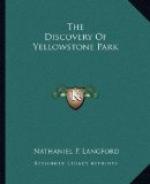side. Toiling on our course down this creek to
the river we came suddenly upon a basin of boiling
sulphur springs, exhibiting signs of activity and points
of difference so wonderful as to fully absorb our
curiosity. The largest of these, about twenty
feet in diameter, is boiling like a cauldron, throwing
water and fearful volumes of sulphurous vapor higher
than our heads. Its color is a disagreeable greenish
yellow. The central spring of the group, of dark
leaden hue, is in the most violent agitation, its
convulsive spasms frequently projecting large masses
of water to the height of seven or eight feet.
The spring lying to the east of this, more diabolical
in appearance, filled with a hot brownish substance
of the consistency of mucilage, is in constant noisy
ebullition, emitting fumes of villainous odor.
Its surface is covered with bubbles, which are constantly
rising and bursting, and emitting sulphurous gases
from various parts of its surface. Its appearance
has suggested the name, which Hedges has given, of
“Hell-Broth springs;” for, as we gazed
upon the infernal mixture and inhaled the pungent
sickening vapors, we were impressed with the idea
that this was a most perfect realization of Shakespeare’s
image in Macbeth. It needed but the presence of
Hecate and her weird band to realize that horrible
creation of poetic fancy, and I fancied the “black
and midnight hags” concocting a charm around
this horrible cauldron. We ventured near enough
to this spring to dip the end of a pine pole into
it, which, upon removal, was covered an eighth of an
inch thick with lead-colored sulphury slime.
There are five large springs and half a dozen smaller
ones in this basin, all of them strongly impregnated
with sulphur, alum and arsenic. The water from
all the larger springs is dark brown or nearly black.
The largest spring is fifteen to eighteen feet in
diameter, and the water boils up like a cauldron from
18 to 30 inches, and one instinctively draws back
from the edge as the hot sulphur steam rises around
him. Another of the larger springs is intermittent.
The smaller springs are farther up on the bank than
the larger ones. The deposit of sinter bordering
one of them, with the emission of steam and smoke combined,
gives it a resemblance to a chimney of a miner’s
cabin. Around them all is an incrustation formed
from the bases of the spring deposits, arsenic, alum,
sulphur, etc. This incrustation is sufficiently
strong in many places to bear the weight of a man,
but more frequently it gave way, and from the apertures
thus created hot steam issued, showing it to be dangerous
to approach the edge of the springs; and it was with
the greatest difficulty that I obtained specimens
of the incrustation. This I finally accomplished
by lying at full length upon that portion of the incrustation
which yielded the least, but which was not sufficiently
strong to bear my weight while I stood upright, and
at imminent risk of sinking in the infernal mixture,
I rolled over and over to the edge of the opening;
and, with the crust slowly bending and sinking beneath
me, hurriedly secured the coveted prize of black sulphur,
and rolled back to a place of safety.




